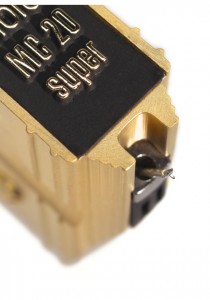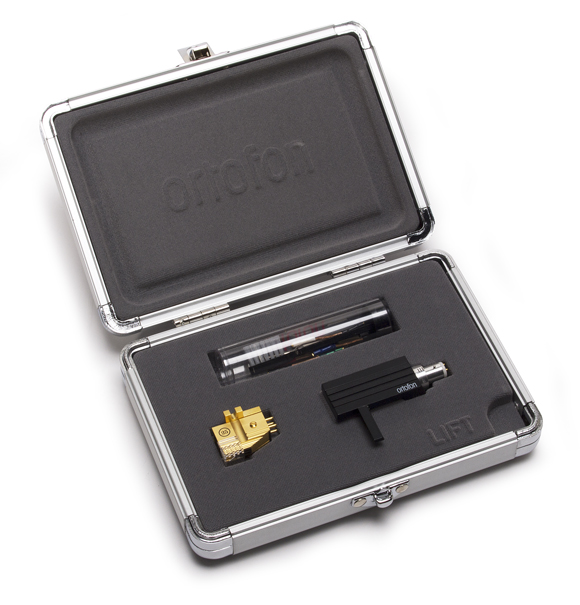Ortofon MC 20 Cartridge
From the late 1970s through the mid-1980s, the MC 20 was one of best-selling low output moving coil cartridges and a welcome surprise when compared to the other paltry options available.
An alternative to Japanese offerings from Denon, Supex, and Fidelity Research, it graced many a high-end turntable. As luck would have it, the Super version came out in 1985, just as CDs began to take off in popularity. Bummer. But if you missed it back then, here’s your chance to enjoy it anew.
The 25th anniversary edition comes nicely packaged in a mini aluminum case reminiscent of a Zero Halliburton metal briefcase. Inside, one finds the gold aluminum-bodied cartridge, requisite mounting hardware, and an NOS universal Ortofon headshell that also offers azimuth and overhang adjustments. Considering that it’s just $800, the MC 20 Super doesn’t shirk on presentation.
Staying True to Retro Roots
Thinking that a retro cartridge might work well in a retro tone arm, I recently purchased the ten-inch version of the SME M2, the closest one can come to getting a classic 3009 arm these days. It even has an identical mounting method, as the arm fits into the mounting cutouts into which the older arm fit. To complete the retro theme, I tried the arm/cartridge combination on a vintage Luxman PD-121 direct-drive turntable. The combined arm/cartridge resonant frequency turned out to be in the ideal range of 9.6Hz. Once properly aligned, and with the tracking force adjusted to the recommended 1.8 grams, the setup looked outstanding. Keeping everything in the SME vein precluded use of the Ortofon headshell that will now be put to good use in one of my other turntables.
I evaluated the MC 20 Super with a PS Audio GPCH phonostage that’s modified with a full range of Cullen Circuits upgrades. While Ortofon recommends loading the cartridge with greater than 10 ohms, 100 ohms yielded the best results in my system. Anything less proved too bright and dulled transient attack.
 Slight Break-In Required
Slight Break-In Required
Initially, the sound tilted toward bright and steely, so I put about 30 hours on the cartridge before settling down to critically listen. After the MC 20 Super traced its way through a handful of albums, the sound significantly smoothed out and took on a much more engaging character.
Pure Pleasure’s recently released reissue of Keb’ Mo’s Peace, Back By Popular Demand proved a new joy to hear. The singer/guitarist’s cover of Buffalo Springfield’s “For What It’s Worth” showed off two of the Ortofon’s biggest strengths: bass attack and dynamics. The bass drum boasted a “punch you in the chest” quality while the percussive wood block appeared in the soundstage with a sudden “crack.” Vocals were unstrained, very natural sounding, and without the bloat that many budget MC cartridges instill in the interest of providing a warm presentation.
Next, to get a better feel for the acoustic performance, I tried the first Gateway recording by John Abercrombie, Dave Holland, and Jack DeJohnette. During “Back-Woods Song,” Holland’s bass lines were clearly delineated while DeJohnette’s busy, melodic drumming remained punchy on the snare and shimmering and airy on the cymbals. At once ethereal and biting, Abercrombie’s guitar floated above the rhythm section. On “Waiting,” the cymbal attacks were fast and ideally detailed, and the stand-up bass full and resonant. I immediately forgot about the cartridge and enjoyed the music.
To increase the torture test and find out how the MC 20 Super would reproduce a full orchestra, I chose Sir Adrian Boult conducting the London Philharmonic Orchestra’s performance of Elgar’s Falstaff-Symphonic Study on EMI/Odeon. Here, the full width and depth of the concert hall revealed itself to scale, providing extremely accurate string sound sans artificial or annoying artifacts—a tough hurdle to jump even with the best cartridges. The realistic swell and ebb of the dynamic peaks is tough to track all the way through, yet posed no problem for the MC 20 Super.
Finally, to get a handle on the Ortofon’s ability to accurately portray vocals, I spun John Coltrane And Johnny Hartman, one of the most natural vocal recordings ever made. While many listeners use female vocals for evaluation, I believe male vocals are the more difficult of the two for gear to resolve. The Ortofon put Johnny Hartman in the room squarely between the speakers, and without any undue spotlighting. Once again, the all-important mid-bass region remained totally devoid of coloration. In addition to the superb vocal performance, Coltrane’s sax came across as round, breathy, and smooth.
 Head of the Class
Head of the Class
Competition is fierce once you approach the $1,000 level in phono cartridges, especially considering that there are plenty of great models moving magnet, moving coil, and moving iron cartridges from which to choose. Such cartridges lack the level of refinement and resolution that high-dollar models provide, so musicality rules the day when shopping in this neighborhood. And musicality is what the Ortofon MC 20 Super offers in abundance. Highly recommended.
You can purchase an MC20 Super from The Needle Doctor here…
The Ortofon MC 20 Super Phono Cartridge
MSRP: $899
Manufacturer Site: www.ortofon.com



